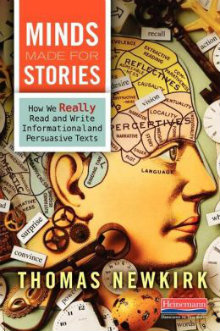Learning Non-Fiction with Minds Made for Stories
Minds Made for Stories: How We Really Read and Write Informational and Persuasive Texts
By Thomas Newkirk
(Heinemann, 2014 – Learn more)

It has been nearly impossible for me to escape the buzz about Thomas Newkirk’s most recent book, Minds Made for Stories. So many of the educators that I read and respect online urged everyone they knew to pick up a copy. On his Twitter account, Barry Lane called it “the most important book published this year.”
With so many recommendations, my expectations were quite high as I read this book. I’m pleased to say that I found this book well deserving of all of the accolades. Minds Made for Stories has a powerful message that needs to be shared.
Narrative drives learning
Newkirk begins one chapter with a quote by Jim McElhaney that underscores the theme of this entire book:
Stories are how we understand the interrelationship of events. Stories are at the heart of how we learn because they create memories and provide details we want to know. Stories grab us in a way no list of facts could ever do.”

To underscore his point, Newkirk also emphasizes the broad definition of the words story and narrative. As educators, we often see narrative as a specific type of writing (taught during a specific unit in the year) and stories as something told to young children to entertain them. But Newkirk asserts that stories and narratives are the very foundation of clear thinking and understanding.
For teachers of all subjects
Throughout this book, Newkirk uses examples to help broaden the definition and experience of story. He refers to varied instances from history, science and math to show that humans understand and retain information better when it is framed through a narrative, rather than a dry set of facts (such as a phone book – and who remembers random details from a phone book?) He offers insights that can be translated into different disciplines and used by teachers of all subjects.
Narrative to improve attention and retention
When we put together our lessons and objectives by using the structure of story, Newkirk argues, our students will attend to and retain the information much better. To quote him again: “If the goal of reading nonfiction is to retain what we read – a reasonable assumption – attention is crucial, for we generally don’t retain things we don’t attend to.”
Since we want our students to attend to our lessons and retain the information we teach, weaving a narrative throughout that information will assist them as they assimilate the volume of information they encounter each day.
During the course of reading Minds Made for Stories, I discovered a quote from Neil Gaiman. He shared a story about his cousin that, I think, perfectly illustrates the message of Thomas Newkirk’s powerful book. Gaiman says:
My cousin Helen, who is in her 90s now, was in the Warsaw ghetto during World War II. She and a bunch of the girls in the ghetto had to do sewing each day. And if you were found with a book, it was an automatic death penalty. She had gotten hold of a copy of ‘Gone With the Wind’, and she would take three or four hours out of her sleeping time each night to read. And then, during the hour or so when they were sewing the next day, she would tell them all the story. These girls were risking certain death for a story.
And when she told me that story herself, it actually made what I do feel more important. Because giving people stories is not a luxury. It’s actually one of the things that you live and die for.”
Stories are not something we can take or leave; they actually are the framework and structure of our lives. They are integral to our world and provide us ways of interacting and learning that give shape and meaning to our days, and – for our students – structure for our lessons that will help them with retention and comprehension.
Jenni Miller is a 6th grade Language Arts teacher at Montevideo Middle School in Penn Laird, Virginia. She is in her 21st year of teaching there and absolutely loves reading and writing with her middle school students every day. She also loves Pinterest and frequently pins for middle school teachers and students alike. She can be found at www.pinterest.com/jmillermms and on Twitter@soosen.



































I think it is a very good blog both for the parents as well as the students. The articles are really helpful.
We’re using Newkirk’s book as the overall concept for a summer camp/professional development program just getting started through our National Writing Project site. Thanks for the fine overview, which I am going to send to our teacher-participants.
Kevin